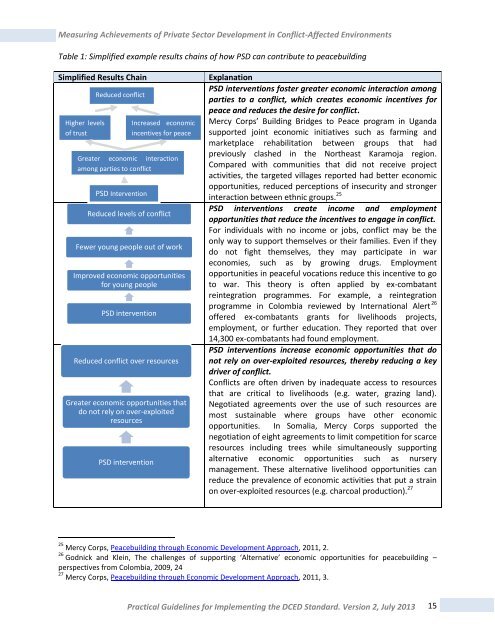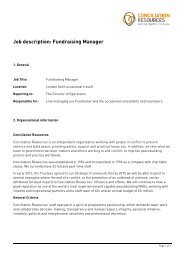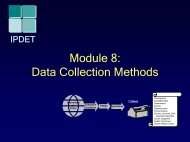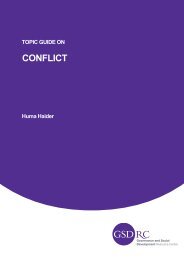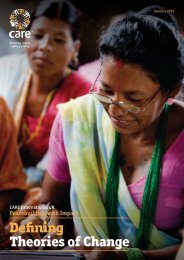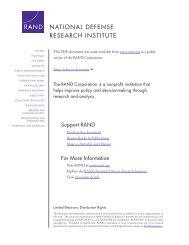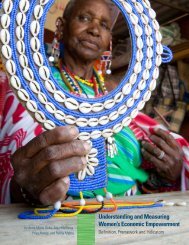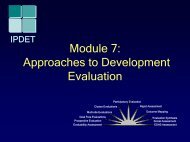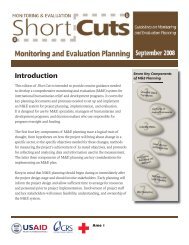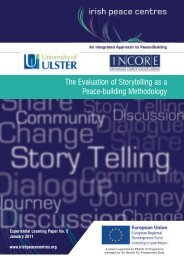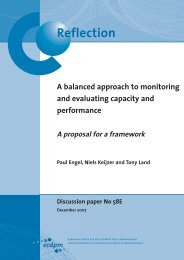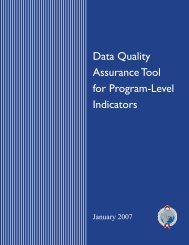Measuring Achievements of Private Sector Development in ... - DCED
Measuring Achievements of Private Sector Development in ... - DCED
Measuring Achievements of Private Sector Development in ... - DCED
You also want an ePaper? Increase the reach of your titles
YUMPU automatically turns print PDFs into web optimized ePapers that Google loves.
<strong>Measur<strong>in</strong>g</strong> <strong>Achievements</strong> <strong>of</strong> <strong>Private</strong> <strong>Sector</strong> <strong>Development</strong> <strong>in</strong> Conflict-Affected Environments<br />
Table 1: Simplified example results cha<strong>in</strong>s <strong>of</strong> how PSD can contribute to peacebuild<strong>in</strong>g<br />
Simplified Results Cha<strong>in</strong><br />
Higher levels<br />
<strong>of</strong> trust<br />
Reduced conflict<br />
Reduced levels <strong>of</strong> conflict<br />
Fewer young people out <strong>of</strong> work<br />
Improved economic opportunities<br />
for young people<br />
PSD <strong>in</strong>tervention<br />
Reduced conflict over resources<br />
Greater economic opportunities that<br />
do not rely on over-exploited<br />
resources<br />
PSD <strong>in</strong>tervention<br />
Increased economic<br />
<strong>in</strong>centives for peace<br />
Greater economic <strong>in</strong>teraction<br />
among parties to conflict<br />
PSD Intervention<br />
Explanation<br />
PSD <strong>in</strong>terventions foster greater economic <strong>in</strong>teraction among<br />
parties to a conflict, which creates economic <strong>in</strong>centives for<br />
peace and reduces the desire for conflict.<br />
Mercy Corps’ Build<strong>in</strong>g Bridges to Peace program <strong>in</strong> Uganda<br />
supported jo<strong>in</strong>t economic <strong>in</strong>itiatives such as farm<strong>in</strong>g and<br />
marketplace rehabilitation between groups that had<br />
previously clashed <strong>in</strong> the Northeast Karamoja region.<br />
Compared with communities that did not receive project<br />
activities, the targeted villages reported had better economic<br />
opportunities, reduced perceptions <strong>of</strong> <strong>in</strong>security and stronger<br />
<strong>in</strong>teraction between ethnic groups. 25<br />
PSD <strong>in</strong>terventions create <strong>in</strong>come and employment<br />
opportunities that reduce the <strong>in</strong>centives to engage <strong>in</strong> conflict.<br />
For <strong>in</strong>dividuals with no <strong>in</strong>come or jobs, conflict may be the<br />
only way to support themselves or their families. Even if they<br />
do not fight themselves, they may participate <strong>in</strong> war<br />
economies, such as by grow<strong>in</strong>g drugs. Employment<br />
opportunities <strong>in</strong> peaceful vocations reduce this <strong>in</strong>centive to go<br />
to war. This theory is <strong>of</strong>ten applied by ex-combatant<br />
re<strong>in</strong>tegration programmes. For example, a re<strong>in</strong>tegration<br />
programme <strong>in</strong> Colombia reviewed by International Alert 26<br />
<strong>of</strong>fered ex-combatants grants for livelihoods projects,<br />
employment, or further education. They reported that over<br />
14,300 ex-combatants had found employment.<br />
PSD <strong>in</strong>terventions <strong>in</strong>crease economic opportunities that do<br />
not rely on over-exploited resources, thereby reduc<strong>in</strong>g a key<br />
driver <strong>of</strong> conflict.<br />
Conflicts are <strong>of</strong>ten driven by <strong>in</strong>adequate access to resources<br />
that are critical to livelihoods (e.g. water, graz<strong>in</strong>g land).<br />
Negotiated agreements over the use <strong>of</strong> such resources are<br />
most susta<strong>in</strong>able where groups have other economic<br />
opportunities. In Somalia, Mercy Corps supported the<br />
negotiation <strong>of</strong> eight agreements to limit competition for scarce<br />
resources <strong>in</strong>clud<strong>in</strong>g trees while simultaneously support<strong>in</strong>g<br />
alternative economic opportunities such as nursery<br />
management. These alternative livelihood opportunities can<br />
reduce the prevalence <strong>of</strong> economic activities that put a stra<strong>in</strong><br />
on over-exploited resources (e.g. charcoal production). 27<br />
25 Mercy Corps, Peacebuild<strong>in</strong>g through Economic <strong>Development</strong> Approach, 2011, 2.<br />
26 Godnick and Kle<strong>in</strong>, The challenges <strong>of</strong> support<strong>in</strong>g ‘Alternative’ economic opportunities for peacebuild<strong>in</strong>g –<br />
perspectives from Colombia, 2009, 24<br />
27 Mercy Corps, Peacebuild<strong>in</strong>g through Economic <strong>Development</strong> Approach, 2011, 3.<br />
Practical Guidel<strong>in</strong>es for Implement<strong>in</strong>g the <strong>DCED</strong> Standard. Version 2, July 2013<br />
15


